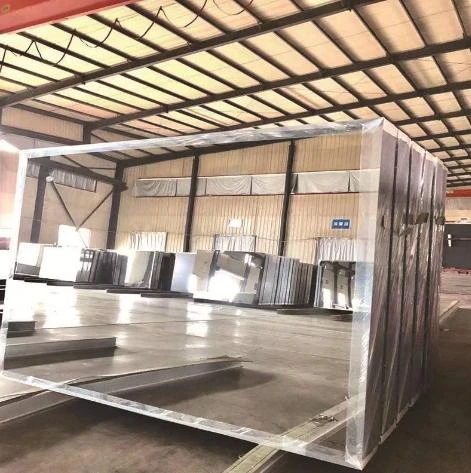Architectural Glass Uses A Multifaceted Material Transforming Spaces
Architectural glass is a vital component in modern buildings, revolutionizing both aesthetics and functionality. With its remarkable versatility, it finds applications in various structures—from residential to commercial—and serves numerous purposes, enhancing the overall design and energy efficiency.
1. Aesthetic Appeal
One of the primary uses of architectural glass is its ability to enhance the visual appeal of a structure. Glass facades allow for vast expanses of light to penetrate interiors, creating open and airy spaces that connect occupants with the outside environment. These facades are not just visually stunning but also contribute to a building’s contemporary look, making it stand out in urban landscapes. The use of tinted, frosted, or patterned glass adds further aesthetic value, enabling architects to express their creativity while meeting functional needs.
2. Natural Light and Energy Efficiency
Natural light is a cornerstone of modern architectural design, and glass plays a pivotal role in maximizing daylight within a building. By using large glass windows or skylights, natural illumination reduces the need for artificial lighting during the day, which can significantly decrease energy consumption. Moreover, advancements in glass technology, such as low-emissivity (Low-E) coatings, allow for better thermal insulation while permitting ample sunlight. This dual benefit helps maintain a comfortable indoor climate and lowers energy costs, making buildings more sustainable.
3. Safety and Security
Safety is paramount in architectural design, and glass can be engineered to enhance security. Laminated and tempered glass options are commonly used in buildings to improve safety in the event of breakage. Laminated glass features a layer of polyvinyl butyral (PVB) between two sheets of glass, ensuring that shards remain intact, reducing the risk of injury. Similarly, tempered glass is heat-treated for increased strength, making it more resistant to impact. These safety features are essential in high-traffic areas, like shopping malls and office buildings, where the risk of breakage is elevated.
architectural glass uses
4. Noise Reduction
In bustling urban environments, noise pollution can be a significant concern. Architectural glass can help mitigate this issue through the use of specialized acoustic glass. This type of glass incorporates additional layers or materials that reduce sound transmission, creating quieter indoor spaces. By incorporating noise-reducing glass in windows and facades, architects can provide occupants with a more serene living and working environment, enhancing overall comfort and productivity.
5. Innovative Applications
The uses of architectural glass extend beyond just windows and facades. Glass is increasingly being used in innovative ways, including glass partitions, balustrades, and even structural elements like glass beams. These applications not only contribute to an open, cohesive design but also leverage the strength and durability of glass, which can often support significant loads. Additionally, smart glass technology is emerging as a groundbreaking application, allowing glass to change transparency or tint in response to environmental conditions. This development offers architects greater flexibility in controlling light and privacy without sacrificing aesthetics.
6. Sustainability and Environmental Considerations
As sustainability becomes a crucial consideration in architectural design, glass plays an essential role in eco-friendly buildings. Recycled glass products are increasingly being utilized, and many manufacturers focus on environmentally responsible production processes. Moreover, the reflectivity and insulation properties of architectural glass can contribute to LEED certification—an important standard for energy-efficient buildings.
Conclusion
Architectural glass is an unparalleled material that enhances the aesthetic, functional, and sustainable aspects of modern architecture. Its ability to provide natural light, improve energy efficiency, and increase safety makes it an invaluable asset in building design. As technology continues to advance, the applications and possibilities for architectural glass will only expand, promising exciting developments in the way we conceive and construct our environments. Whether in towering skyscrapers or intimate homes, architectural glass is redefining our built environment, ensuring it is not only beautiful but also functional and efficient.
 Afrikaans
Afrikaans  Albanian
Albanian  Amharic
Amharic  Arabic
Arabic  Armenian
Armenian  Azerbaijani
Azerbaijani  Basque
Basque  Belarusian
Belarusian  Bengali
Bengali  Bosnian
Bosnian  Bulgarian
Bulgarian  Catalan
Catalan  Cebuano
Cebuano  Corsican
Corsican  Croatian
Croatian  Czech
Czech  Danish
Danish  Dutch
Dutch  English
English  Esperanto
Esperanto  Estonian
Estonian  Finnish
Finnish  French
French  Frisian
Frisian  Galician
Galician  Georgian
Georgian  German
German  Greek
Greek  Gujarati
Gujarati  Haitian Creole
Haitian Creole  hausa
hausa  hawaiian
hawaiian  Hebrew
Hebrew  Hindi
Hindi  Miao
Miao  Hungarian
Hungarian  Icelandic
Icelandic  igbo
igbo  Indonesian
Indonesian  irish
irish  Italian
Italian  Japanese
Japanese  Javanese
Javanese  Kannada
Kannada  kazakh
kazakh  Khmer
Khmer  Rwandese
Rwandese  Korean
Korean  Kurdish
Kurdish  Kyrgyz
Kyrgyz  Lao
Lao  Latin
Latin  Latvian
Latvian  Lithuanian
Lithuanian  Luxembourgish
Luxembourgish  Macedonian
Macedonian  Malgashi
Malgashi  Malay
Malay  Malayalam
Malayalam  Maltese
Maltese  Maori
Maori  Marathi
Marathi  Mongolian
Mongolian  Myanmar
Myanmar  Nepali
Nepali  Norwegian
Norwegian  Norwegian
Norwegian  Occitan
Occitan  Pashto
Pashto  Persian
Persian  Polish
Polish  Portuguese
Portuguese  Punjabi
Punjabi  Romanian
Romanian  Russian
Russian  Samoan
Samoan  Scottish Gaelic
Scottish Gaelic  Serbian
Serbian  Sesotho
Sesotho  Shona
Shona  Sindhi
Sindhi  Sinhala
Sinhala  Slovak
Slovak  Slovenian
Slovenian  Somali
Somali  Spanish
Spanish  Sundanese
Sundanese  Swahili
Swahili  Swedish
Swedish  Tagalog
Tagalog  Tajik
Tajik  Tamil
Tamil  Tatar
Tatar  Telugu
Telugu  Thai
Thai  Turkish
Turkish  Turkmen
Turkmen  Ukrainian
Ukrainian  Urdu
Urdu  Uighur
Uighur  Uzbek
Uzbek  Vietnamese
Vietnamese  Welsh
Welsh  Bantu
Bantu  Yiddish
Yiddish  Yoruba
Yoruba  Zulu
Zulu 

